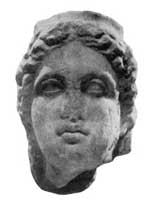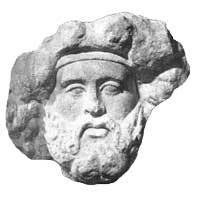

Many-years-long archaeological excavations on the territory of the ancient Chersonesos and its agricultural environs discovered more than 650 monuments of statuary. At present, the most part of these artifacts is kept in the About Chersonesos, though few isolated finds are in the largest museums of Ukraine (in Odessa Archaeological Museum) and Russia (in State Hermitage Museum in Saint-Petersburg and State Historical Museum in Moscow).Unfortunately, some monuments are lost now.

|
The history of scholarly studies in Chersonesos explains why its collection of sculptures is disordered and many fine pieces from this collection are lost. The thing is that the first excavations of this ancient city were made as early as 1827, when there was no museum in Chersonesos, and the finds, including sculptures, scattered through the museums of the Russian empire. Such a situation existed till 1892, when Karl Kostsyushko-Valyuzhinich's enthusiasm created "Warehouse of local antiquities", the prototype of the present museum. |
|
But even then, the most interesting finds that certainly included statuary were exported to Hermitage museum because, from 1888, excavations of Chersonesos were funded by the Imperial Archaeological Commission. |

|
The evacuation of the museum to Kharkov in the years of the First World War did not come without losses. Yet the museum collection suffered a lot in the years of the Second World War. Although the best exhibits from the show rooms and museum storage were evacuated to Sverdlovsk in Ural region (now Yekaterinburg), a part of the monuments, which had been left at place, were never found later on. It was 1925 when Konstantin Grinevich supervised over the creation of the first scholarly museum exposition, which included monuments of statuary side by side with other artifacts.
|
It was 1958 when Chersonesos museum started the organization of a special storage, lapidarium of statuary, for which more than 200 monuments were selected from the main storage. At that time, it was planned to make a permanent museum display in the lapidarium and to arrange this display according to historical method, with singling out different groups and categories of statuary. Unfortunately, the above task has not been solved completely to these days. At present, the collection of sculpture in the About Chersonesos has about 600 pieces and is enlarged with new specimens almost annually, which is why it is impossible to locate all these monuments, according to their groups and categories, because of a very small area of the premise selected for the lapidarium of statuary. |

|
Chersonesos collection of sculptures includes the categories of monuments as below:
- statues, statuettes, and relieves of mythological figures of Greek and Roman pantheons;
- portrait sculpture;
- funeral monuments of various styles (classical, shaped like high narrow steles; anthropomorphic; with draped figures; with scenes of funeral repast; with half-length image of a man; showing veiled woman; of Roman soldiers, 'barbarian', and others);
- fragments of sarcophagi;
- decorative statuary;
- altars;
- early Christian statuary.

|
Chersonesos collection's distinctive feature is almost absence of complete, not fragmented, sculptures. Statuary group of Aphrodite with two Erotes, which was found in 1978 in the Gerakleyskiy peninsula, is perhaps the only intact monument among the statuettes. Some pieces of gravestones and separate relieves preserved better, but these constitute a very small percentage of the whole parcel of sculpture wares. |
|
This situation might be caused by the circumstance that the citizens of Chersonesos must destroy images of pagan gods and heroes in the period when Christianity was being introduced as a state religion. It is very difficult to establish the chronology of the monuments of statuary because they are broken into smallest fragments, but one can be convinced that the most part of the collection is the first centuries A. D. copies, though the originals were made in classical and Hellenistic periods. |

|
It is hard to infer how much were there the number of pieces of high artistic quality in Chersonesos basing on the small fragments only. At any rate, Chersonesos developed a good taste and a high requirements for the works of art, as it can be seen from the monuments like Caryatid head, Aphrodite torso, head of a young athlete of the school of Skopas (they all are displayed in Ancient Exhibition Hall), woman head, statuette of Eros (both fragments are in the statuary lapidarium) and some other monuments.
